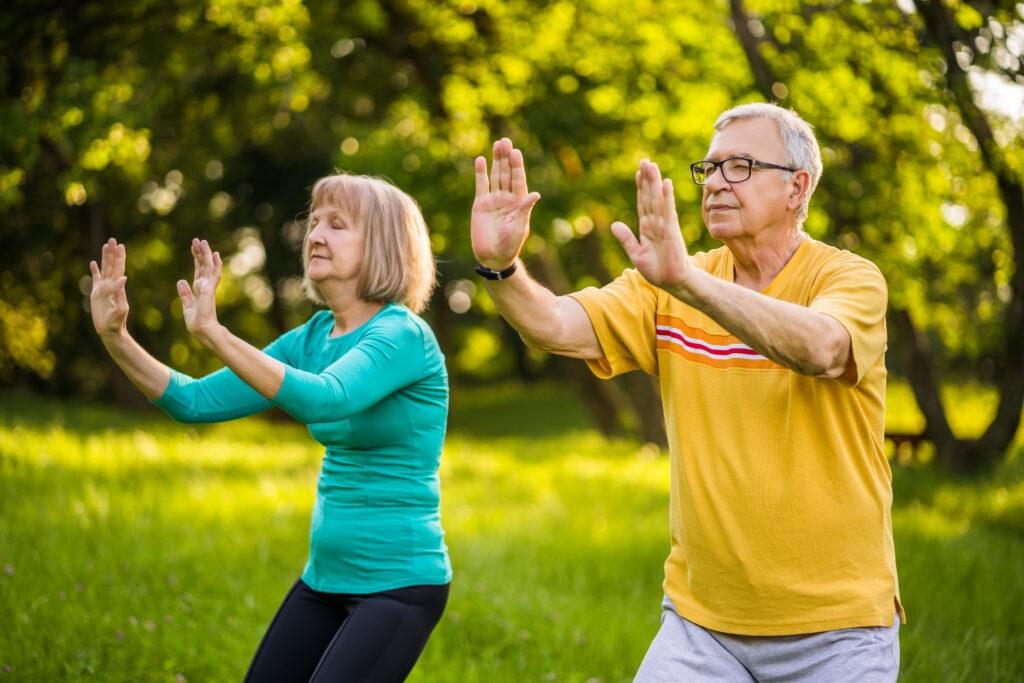While spring is full of charms—the blossoming of flowers, the return of the birds from warmer climes, and the long-awaited reemergence of the sun—it can also be a difficult time for those with chronic pain like osteoarthritis. Fluctuations in temperature can cause the barometric pressure to shift, exacerbating joint pain especially. Tai chi for seniors can be an effective way to manage such pain and make some friends along the way.

What Is Tai Chi?
Tai Chi is an ancient martial art that originated in China. The form, sometimes described as “meditation in motion,” focuses on a continuous progression of gentle exercises that invigorates the mind, body, and spirit. The combination of slow movement and physical stances with controlled breathing and a meditative state of mind improves strength, balance, and endurance. To this end, tai chi has also been referred to as “medication in motion.”
An Ancient Way to Manage Pain
The flowing movements of tai chi are beautiful, but that is not their only benefit. The “internal” martial art has also been shown to be an effective resource in rehabilitation and health promotion. As mentioned above, the low-impact nature of the exercise is highly beneficial for loosening up stiffness commonly associated with joint pain.
In this way, tai chi for seniors is a natural way to manage arthritis, without the need for medications and their adverse side effects. In addition, regularly practicing tai chi can improve flexibility, balance, muscular strength, and overall fitness in addition to equanimity and calmness of spirit.

Is Tai Chi Better Than Physical Therapy?
Physical therapy is an invaluable resource especially after a trauma like surgery or injury. In 2016, a study was published comparing the effectiveness of tai chi and physical therapy. Researchers observed two groups suffering from osteoarthritis and treated one with physical therapy and the other with tai chi.
The study lasted for 12 weeks and administered physical therapy or tai chi both in-office and encouraged the practices to continue at home. At the conclusion of the study, all participants reported improved pain relief that was comparable between the two groups. However, the tai chi group also experienced greater mood improvements and better quality of life. Researchers concluded that tai chi for seniors is physically comparable to physical therapy but it adds the important element of mental and emotional elevation.
Is Tai Chi Better Than Yoga for Seniors?
Tai chi and yoga have many similarities. Both disciplines include low-intensity exercise and are rooted in ancient cultures. Both have been proven to improve flexibility, balance, strength, reflexes, mobility, and range of motion. They also have been shown to improve mental and emotional health (such as critical thinking skills, mood, and overall quality of life) in addition to physical health. Both can mitigate pain, and both have been shown to be especially beneficial for older adults.
To accomplish all of these things, both yoga and tai chi address many health systems and work synergistically. They do so by prioritizing meditation and deep breathing in addition to gentle sequences of motion to promote both physical and mental well-being. This is different from other treatments like medication that only target one aspect of health.
So which is better for seniors, yoga or tai chi? The answer depends on what you hope the exercise will achieve.
As a general rule, yoga employs more static poses, transitioning to a position like warrior 1 or downward dog and holding it for several breaths. On the other hand, tai chi focuses on one slow, continuous sequence. Many seniors prefer the fluid movements of tai chi as they are not as demanding as other forms of physical activity.

Is Tai Chi for Seniors Better Than Walking?
Walking is another common form of senior exercise. It is a powerful way to stave off cardiovascular disease and other conditions for which physical inactivity is a major risk factor. Results indicate that tai chi shares many of the positive health benefits that walking has, especially as regards reduction in cardiovascular disease risk. This is likely due to the fact that the energy expenditure in tai chi for seniors is comparable to that of walking.
What Is the Best Kind of Tai Chi for Seniors?
There are three basic styles of tai chi: chen, sun, yang, and wu. Each is unique and presents different advantages. Because of its popularity and the accessibility of learning materials and classes, many agree that yang is the best style of tai chi for seniors. Wu has very similar low-impact and flowing movements and is also a good choice. If you prefer, there are several tai chi exercises that can be completed while sitting down.
Call Us: 801-653-1291